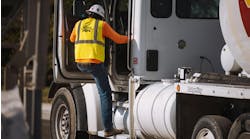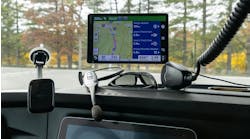Advanced driver assistance systems are steadily gaining popularity and proving useful. At the same time, fleets find that integrating those capabilities with their transportation management systems can enhance safety.
“Technology that can seamlessly capture what’s happening on the road and relay it instantly to back-office staff, with real-time bidirectional communication, can significantly enhance safety,” said Paul Cardosi, Americas VP of telematics and fleet management at Trimble Transportation.
“Multiple synchronized data streams such as video, truck position, engine, and remaining hours of service information can help dispatch and safety staff understand road conditions, truck health, unsafe driving events, and remaining driving hours,” Cardosi told FleetOwner.
A TMS that informs your operations team of ongoing safety considerations enhances compliance and reduces the risk of fines and penalties, noted Lora Hillebrand, director of account management at PCS Software. “That prevents missed deadlines and saves time and resources by streamlining tasks like scheduling physicals, drug tests, and recording CDL expirations,” she explained.
See also: Fleets Explained: What is a TMS?
Information creates safety
“A TMS can allow drivers to stay focused on their most important job, which is driving safely,” said Ben Wiesen, president of Carrier Logistics Inc. “Onboard technology allows a driver’s activity, such as arrivals and departures and location updates, to be shared with dispatchers without the necessity for any communication that could cause distraction. And because the TMS always knows where the driver is, if there is an accident or emergency, the response time to support the driver is much faster.”
Fleets can leverage data from a vehicle to review incidents or near incidents for training and coaching, noted Volvo’s Gustafson. Overall, awareness fosters a culture of safer drivers.
The more data the better, according to Norton at Detroit. “A healthy truck is a safer truck,” he added. “ADAS systems can provide a tremendous amount of data that fleet managers can analyze to make connections between things like maintenance practices and optimal safety system functionality.”
Trimble's Cardosi said the key to executing a robust safety program includes leveraging in-cab technologies. But in many ways, safety starts with planning. “For example, ELD HOS data from a fleet management system correlated with truck position, trip data, delivery windows, and estimated time of arrival allows drivers to complete trips safely at safe speeds and without fear of running out of hours of service.”
E-Smart’s Joe Thell pointed out that while in-cab technologies generate volumes of data that can be mined for insights into driver behaviors and vehicle performance to help fleets uncover new opportunities, the downside can be the number of reports that must be actively monitored. “But the trucking industry seems to be striking a balance between generating reports that can improve safety performance and taking immediate action in situations that are best solved with automated intervention,” he said.
Onboard safety systems can provide a wide variety of information, noted Hans Galland, CEO of BeyondTrucks. Examples include risky driving behavior, hours of service data, signals of fatigue or distracted driving, and files on licenses and endorsements.
According to Lora Hillebrand at PCS, an ADAS system can provide valuable data on driver behavior, allowing drivers who may need additional training to be identified, and the integration of an ELD with a TMS permits real-time access to hours of service data. “That also simplifies dispatching by eliminating the need for manual data entry,” she explained.
“ELDs and telematics allow real-time tracking of locations, speed, fuel, and performance, which enhances operations management by providing more efficient route planning and asset utilization, and it can help address detention time issues,” said Isaac’s Simard.
“Safety concerns typically arise from driver errors, factors external to the truck, or issues arising mechanically,” Vanderheide at Intangles said. “Onboard systems help equip drivers to be in the best state of mind possible to minimize their risk.
Future safety developments
“There is a wealth of knowledge coming from trucks—and we can now leverage artificial intelligence to optimize operations like never before,” Vanderheide continued. “AI can help us move from making macro decisions about safety in the form of policies to a far more streamlined and efficient approach that allows us to enhance fleet operations by taking a micro approach and develop targeted, real-time enhancements and strategies.”
Well-designed back-office systems already schedule and route drivers effectively and efficiently, which can reduce fatigue-inducing waiting time while providing suitable matches for service with the driver and equipment, Wiesen at Carrier Logistics noted. “With AI algorithms, we can learn about pickup and delivery locations before a driver is dispatched to ensure that a driver with the right equipment type is selected,” he told FleetOwner. “And of course, TMS technology ensures certain shipments like those involving hazardous materials are only assigned to certified drivers.”
Lora Hillebrand at PCS pointed out that developing predictive analytics within a TMS could revolutionize how effective maintenance improves safety. “By identifying potential equipment failures before they occur, you could prevent costly risks,” she said.
“In the future, the interaction between data gathered at the vehicle level and support at the terminal, company headquarters, or shop will be increasingly important,” Hans Galland at BeyondTrucks emphasized. “We expect the role of the driver to gradually but fundamentally change to become an increasingly technical, digital, and data-driven role as an in-cab safety manager.”
The future will be about having robust API capabilities and providing fleets with shared data across platforms to solve problems, Thell at E-Smart said.
“Data, analytics, and AI will play a big role in enhancing safety both in the cab and in the back office,” Trimble’s Cardosi said. “Incorporating machine learning and vision will enrich the data that safety personnel can both see and act on. Though already advanced, we envision this technology will continue to improve.”
“We will continue to serve up data in useful ways as our ADAS systems become more advanced,” said Detroit’s Norton. “As computing power and data speeds grow, you’ll see real-time reporting and analysis as events occur. And as safety systems cover more areas of trucks, they bring in another dimension we can react to and report into connected back-office systems.”
“A key part of future safety is enabled by onboard sensors and embedded diagnostic equipment, which will provide additional insights and alerts to protect the driver and the overall public,” said ZF Group’s Benjamin Brown.
Safety plays a crucial role in all product development strategies at Volvo Trucks North America, Gustafson noted. “Safety data that is easily understood in the back office helps promote safe driving behaviors to protect drivers, motorists, and other road users,” he said.
Thomas at Bendix sees “richer, more robust data availability. The best use of technology is in complementing a fleet’s overall safety culture,” he stated. “As ADAS systems continue to evolve, more features will offer different types of data that fleets can use to design more targeted and effective solutions.”
“The future for safety is having AI models to better analyze data and make better decisions,” Simard at Isaac said. “AI is inherently predictive. It takes a large amount of data and turns it into an actionable tool that will improve how fleets implement, manage, and measure their safety initiatives.”






